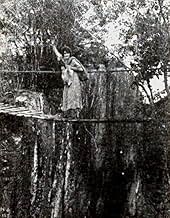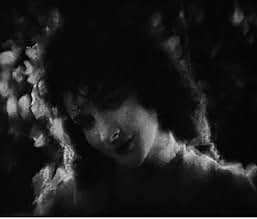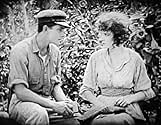Agrega una trama en tu idiomaA man murders his wife's lovers, escapes with his daughter to the South Pacific. A detective pursues him, joined by a young man who eventually falls in love with the daughter.A man murders his wife's lovers, escapes with his daughter to the South Pacific. A detective pursues him, joined by a young man who eventually falls in love with the daughter.A man murders his wife's lovers, escapes with his daughter to the South Pacific. A detective pursues him, joined by a young man who eventually falls in love with the daughter.
- Dirección
- Guionistas
- Elenco
- Dirección
- Guionistas
- Todo el elenco y el equipo
- Producción, taquilla y más en IMDbPro
Opiniones destacadas
The Love Flower (1920) :
Brief Review -
Quite a mix from Griffith but the fact remains intact that such great stories could only be made in that era. Relatable even after 100 years. Forget all those heavy content classics of Griffith, forget those epics, forget those melodramas, those tragedies just for 95 minutes and enjoy this simple but interesting film with no load on your brain. DW Griffith was a completely different director for audience and critics after 'Birth Of The Nation' (1915) and 'Intolerance' (1916). And he even had 10 more classics in those 4 years before making this film so naturally the expectations were different. Contrary to his favourable genre and themes, The Love Flower came as a nice fun break. I am calling it a fun film because i enjoyed it a lot, not that it has any comedy or such stuff. Griffith again made his heroine to do the role of a hero, no directors of that time were doing it continuously as he did and very few directors have done it even till date. Griffith had won me there. In the film, A man murders his wife's lovers and escapes with his daughter to the South Pacific. A detective pursues him, joined by a young man who eventually falls in love with the daughter and then her attempts to save her father begin. It was quite a mix from Griffith, i mean multiple themes together in one narrative and all with dramatic proportions. Nevertheless, the story was itself great for its time and it is great even today. Highly relatable to today's daughters. If somebody had remade this film, I'm sure people would have liked it. I haven't seen much of Carol Dempster's work so for me it was like a fresh face in Griffith film. She was good fortunately. I loved George MacQuarrie in father's role the most. Overall, not a typical Griffith film but a fine typical film afterall.
RATING - 7/10*
By - #samthebestest.
Quite a mix from Griffith but the fact remains intact that such great stories could only be made in that era. Relatable even after 100 years. Forget all those heavy content classics of Griffith, forget those epics, forget those melodramas, those tragedies just for 95 minutes and enjoy this simple but interesting film with no load on your brain. DW Griffith was a completely different director for audience and critics after 'Birth Of The Nation' (1915) and 'Intolerance' (1916). And he even had 10 more classics in those 4 years before making this film so naturally the expectations were different. Contrary to his favourable genre and themes, The Love Flower came as a nice fun break. I am calling it a fun film because i enjoyed it a lot, not that it has any comedy or such stuff. Griffith again made his heroine to do the role of a hero, no directors of that time were doing it continuously as he did and very few directors have done it even till date. Griffith had won me there. In the film, A man murders his wife's lovers and escapes with his daughter to the South Pacific. A detective pursues him, joined by a young man who eventually falls in love with the daughter and then her attempts to save her father begin. It was quite a mix from Griffith, i mean multiple themes together in one narrative and all with dramatic proportions. Nevertheless, the story was itself great for its time and it is great even today. Highly relatable to today's daughters. If somebody had remade this film, I'm sure people would have liked it. I haven't seen much of Carol Dempster's work so for me it was like a fresh face in Griffith film. She was good fortunately. I loved George MacQuarrie in father's role the most. Overall, not a typical Griffith film but a fine typical film afterall.
RATING - 7/10*
By - #samthebestest.
While daddy's girl Carol Dempster (as Stella Bevan) frolics innocently in the woods, trouble is brewing - her loving father (George MacQuarrie as Bevan) and shrewish mother (Florence Short as Mrs. Bevan) are having marital problems. Informed by a faithful servant that his wife is entertaining a lover, Mr. MacQuarrie discovers the trysting twosome; then, during a struggle, he shoots the man dead. To escape from the police, MacQuarrie takes daughter Dempster, and flees to a South Sea island. There, they encounter handsome Richard Barthelmess (as Bruce Sanders), who makes Dempster's heart flutter. She doesn't know it, but Mr. Barthelmess is assisting police detective Anders Randolf (as Crane), who has arrived to arrest her father.
"The Love Flower" is a much better film, overall, than director D.W. Griffith's accompanying South Sea adventure "The Idol Dancer" (1920). G.W. Bitzer's photography is superb; he and Griffith paint some extraordinary, poetic images with the movie camera. The better production values are assisted by the absence of the ludicrous comic relief elements found in "The Idol Dancer". Unfortunately, "The Love Flower" fails to bloom; the melodramatic plot is interesting, but the love story between Dempster and Barthelmess does not work. Their pairing is more dull than passionate, although Barthelmess is a fine performer. Dempster is attractively athletic, and well-photographed; but, her emoting close-ups become sillier and sillier as the movie progresses. The older performers are much better, especially MacQuarrie.
***** The Love Flower (8/22/20) D.W. Griffith ~ Carol Dempster, Richard Barthelmess, George MacQuarrie
"The Love Flower" is a much better film, overall, than director D.W. Griffith's accompanying South Sea adventure "The Idol Dancer" (1920). G.W. Bitzer's photography is superb; he and Griffith paint some extraordinary, poetic images with the movie camera. The better production values are assisted by the absence of the ludicrous comic relief elements found in "The Idol Dancer". Unfortunately, "The Love Flower" fails to bloom; the melodramatic plot is interesting, but the love story between Dempster and Barthelmess does not work. Their pairing is more dull than passionate, although Barthelmess is a fine performer. Dempster is attractively athletic, and well-photographed; but, her emoting close-ups become sillier and sillier as the movie progresses. The older performers are much better, especially MacQuarrie.
***** The Love Flower (8/22/20) D.W. Griffith ~ Carol Dempster, Richard Barthelmess, George MacQuarrie
Griffith was efficient when he filmed what turned out to be Clarine Seymour's final completed movie in April 1920's "The Idol Dancer," where the late actress served as the female lead. Using the backdrops of Ft. Lauderdale, Florida, and Nassau, Bahamas, the director was fulfilling his movie contract with First National by tackling two tropical-based films, "The Idol Dancer" and "The Love Flower."
The later movie starred Griffith's up-and-coming favorite actress, Carol Dempster. Very few people could see the reasoning behind the director's favorability on what critics felt was the young actress' limited talent. A 15-year-older in 'Intolerance' as a harem girl, Dempster slowly emerged as Griffith's primary actress in his early 1920's films. "The Love Flower" was her second co-starring role as a step-daughter of a father who murdered his wife's lover. They both escape on a boat to South Pacific Island, where they're chased down by a persistent detective.
Some praised Dempster for her action sequences, but others complained she was a poor imitation of the Gish sisters as well as veteran Mae Marsh. Such criticism failed to dissuade Griffith from rejecting her and overall "The Love Flower." In fact, he enjoyed the film so much after seeing the reaction of the audience during its premier, he bought the motion picture for $400,000, a considerable amount, from First National for his United Artists' distribution.
The later movie starred Griffith's up-and-coming favorite actress, Carol Dempster. Very few people could see the reasoning behind the director's favorability on what critics felt was the young actress' limited talent. A 15-year-older in 'Intolerance' as a harem girl, Dempster slowly emerged as Griffith's primary actress in his early 1920's films. "The Love Flower" was her second co-starring role as a step-daughter of a father who murdered his wife's lover. They both escape on a boat to South Pacific Island, where they're chased down by a persistent detective.
Some praised Dempster for her action sequences, but others complained she was a poor imitation of the Gish sisters as well as veteran Mae Marsh. Such criticism failed to dissuade Griffith from rejecting her and overall "The Love Flower." In fact, he enjoyed the film so much after seeing the reaction of the audience during its premier, he bought the motion picture for $400,000, a considerable amount, from First National for his United Artists' distribution.
Love Flower, The (1920)
** 1/2 (out of 4)
D.W. Griffith film about a father (George MacQuarrie) who murders his wife's lover and then runs off to a South Sea island with their daughter (Carol Dempster). After a few years a detective shows up looking for him and the daughter decides it's her duty to keep her father with her. A fairly weak story and a stupid message really drags this film down but there are still quite a bit of good things working for the film. The cinematography by G.W. Bitzer is certainly the highlight, especially a couple scenes that take place under water. The three leads all do a decent job but poor Dempster is clearly playing a role meant for Lillian Gish. She can't pull off all the emotions but she does do a good job at playing a young girl.
** 1/2 (out of 4)
D.W. Griffith film about a father (George MacQuarrie) who murders his wife's lover and then runs off to a South Sea island with their daughter (Carol Dempster). After a few years a detective shows up looking for him and the daughter decides it's her duty to keep her father with her. A fairly weak story and a stupid message really drags this film down but there are still quite a bit of good things working for the film. The cinematography by G.W. Bitzer is certainly the highlight, especially a couple scenes that take place under water. The three leads all do a decent job but poor Dempster is clearly playing a role meant for Lillian Gish. She can't pull off all the emotions but she does do a good job at playing a young girl.
THE LOVE FLOWER is one of two DW Griffith films with South Seas settings, filmed at the same time in 1920. Both films showcase two up-and-coming young stars that were part of Griffith's company. THE LOVE FLOWER features Carol Dempster and Richard Barthelmess. The other film is THE IDOL DANCER, starring Clarine Seymour.
Since the story has been explained in other reviews I will just add my perspective on the movie.
SCRIPT: The story seems like a riff on Les Miserables, but isn't very well thought out. Mr Bevan (George MacQuarrie) is ultimately responsible for the death of his wife's lover because he initiated the struggle. Also, the attempts to convince us that Stella's (Carol Dempster) love is motivation enough to attempt to kill a policeman just don't hold water. We are asked to suspend not only our disbelief, but also our ethics. Griffith's flowery intertitles (a common weakness of his) are particularly irksome. SCORE: 3/10.
ACTING: I was particularly impressed with George MacQuarrie's turn as George Bevan. He never really seems to overdo it and turns in a measured performance, managing for the most part to stay away from some of the melodramatic mannerisms that can make silent movies hard to take nowadays. It felt quite modern to me. Anders Randolph, as the determined policeman Crane, also shows control and realism in his portrayal, without coming off as a villain. Richard Barthelmess does well for the most part, although there's not a whole lot of chemistry with the female lead.
She would be Carol Dempster. Though she has been reviled by many, Dempster actually could be superb on quite a few occasions. This would come more frequently later on in her career. She creates touching moments both as the young girl and as a more mature woman devoted to her father, and displays a warmth and charm in her close-ups. She also excels in the more athletic moments, like during her diving, swimming and climbing scenes. However, there are also moments of hand-wringing, arm-flailing melodrama in her performance that undermine her efforts. This is probably Griffith's fault as well, since he was determined to mold her into a facsimile of Lillian Gish or Mae Marsh...for all of his love for her, Griffith didn't seem to know how to consistently play to Dempster's strengths. Florence Short is adequate in her brief part, though she also succumbs to histrionics. ACTING SCORE: 6/10
CINEMATOGRAPHY/PRODUCTION: The cinematography is wonderful. Griffith's most famous and acclaimed cameraman, GW Bitzer, captures the beauty of the scenery (filmed in Florida and the Bahamas) wonderfully. For indoor scenes, he uses an array of long, medium, and close up shots, without resorting to stagey tableaux shots. He shows himself to be a master of his medium. The underwater scenes are also very well done. The editing appears fairly smooth. While not as revolutionary as previous Griffith films, the quality of the scenery and cinematography helps to keep viewer interest even now. SCORE: 8/10
SUMMARY: THE LOVE FLOWER isn't a total bust. It does have good moments. The cinematography is top notch and you can't beat the scenery. However, the performances have their ups and downs, and the story just doesn't work as well as Griffith would have us believe. MOVIE SCORE: 6/10
Since the story has been explained in other reviews I will just add my perspective on the movie.
SCRIPT: The story seems like a riff on Les Miserables, but isn't very well thought out. Mr Bevan (George MacQuarrie) is ultimately responsible for the death of his wife's lover because he initiated the struggle. Also, the attempts to convince us that Stella's (Carol Dempster) love is motivation enough to attempt to kill a policeman just don't hold water. We are asked to suspend not only our disbelief, but also our ethics. Griffith's flowery intertitles (a common weakness of his) are particularly irksome. SCORE: 3/10.
ACTING: I was particularly impressed with George MacQuarrie's turn as George Bevan. He never really seems to overdo it and turns in a measured performance, managing for the most part to stay away from some of the melodramatic mannerisms that can make silent movies hard to take nowadays. It felt quite modern to me. Anders Randolph, as the determined policeman Crane, also shows control and realism in his portrayal, without coming off as a villain. Richard Barthelmess does well for the most part, although there's not a whole lot of chemistry with the female lead.
She would be Carol Dempster. Though she has been reviled by many, Dempster actually could be superb on quite a few occasions. This would come more frequently later on in her career. She creates touching moments both as the young girl and as a more mature woman devoted to her father, and displays a warmth and charm in her close-ups. She also excels in the more athletic moments, like during her diving, swimming and climbing scenes. However, there are also moments of hand-wringing, arm-flailing melodrama in her performance that undermine her efforts. This is probably Griffith's fault as well, since he was determined to mold her into a facsimile of Lillian Gish or Mae Marsh...for all of his love for her, Griffith didn't seem to know how to consistently play to Dempster's strengths. Florence Short is adequate in her brief part, though she also succumbs to histrionics. ACTING SCORE: 6/10
CINEMATOGRAPHY/PRODUCTION: The cinematography is wonderful. Griffith's most famous and acclaimed cameraman, GW Bitzer, captures the beauty of the scenery (filmed in Florida and the Bahamas) wonderfully. For indoor scenes, he uses an array of long, medium, and close up shots, without resorting to stagey tableaux shots. He shows himself to be a master of his medium. The underwater scenes are also very well done. The editing appears fairly smooth. While not as revolutionary as previous Griffith films, the quality of the scenery and cinematography helps to keep viewer interest even now. SCORE: 8/10
SUMMARY: THE LOVE FLOWER isn't a total bust. It does have good moments. The cinematography is top notch and you can't beat the scenery. However, the performances have their ups and downs, and the story just doesn't work as well as Griffith would have us believe. MOVIE SCORE: 6/10
¿Sabías que…?
- TriviaThe Love Flower is free for download on the Internet Archive.
- ConexionesFeatured in Time of the Robots (2012)
Selecciones populares
Inicia sesión para calificar y agrega a la lista de videos para obtener recomendaciones personalizadas
Detalles
Taquilla
- Presupuesto
- USD 300,000 (estimado)
- Tiempo de ejecución
- 1h 35min(95 min)
- Mezcla de sonido
- Relación de aspecto
- 1.33 : 1
Contribuir a esta página
Sugiere una edición o agrega el contenido que falta


























